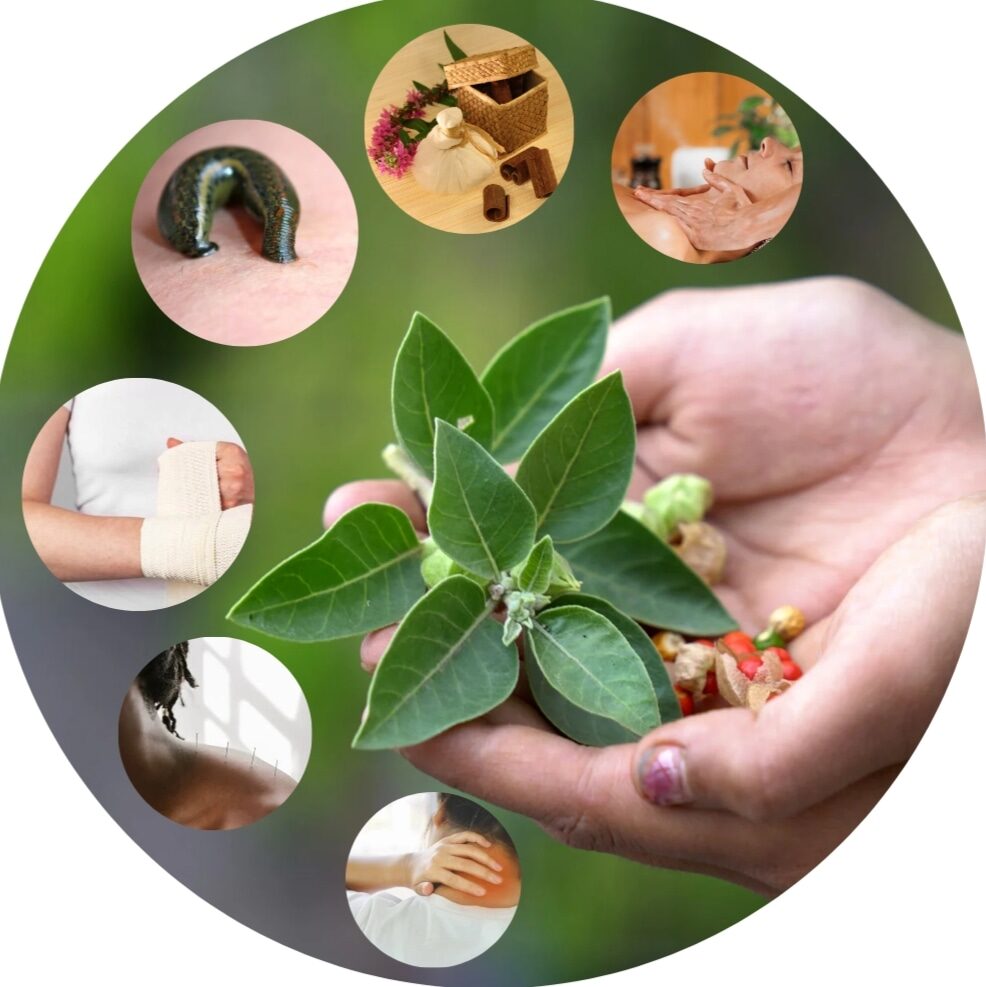Table of Contents
1. Jivaniya Mahakashaya (Vitalizers) in Ayurveda
Jivaniya Mahakashaya, as described in Charaka Samhita (Ch. Su. 4/8), consists of medicinal plants known for their life-sustaining, rejuvenating, and tissue-nourishing properties. These herbs help maintain Sapta Dhatus (seven body tissues), enhance vitality, and promote longevity.
जीवनीय (जीवन) – जीवनम् आयुः तस्मै हितं जीवनीयम् । जीवनीयशब्देनेहायुष्यत्वमभिप्रेतम्। (चक्रपाणि च. सू. 4/8)
जीवनीयं प्राणानां संधारकम् । (इन्दु on अ. सं. सू. 34)
According to Chakrapani, “Jivaniya” refers to substances that are beneficial for life extension. Indu further states that Jivaniya Dravyas sustain Prana (life force), supporting overall health and well-being.
Table: Jivaniya Mahakashaya – Ayurvedic & Pharmacological Profile
| SI No. | Dravya (Herb) | Botanical Name | Rasa (Taste) | Guna (Property) | Vipaka (Post-digestive effect) | Virya (Potency) | Active Compounds |
|---|---|---|---|---|---|---|---|
| 1 | Jivaka | Microstylis wallichii | Madhura | Guru, Snigdha | Madhura | Shita | Alkaloids, Saponins, Flavonoids |
| 2 | Rishabhaka | Microstylis mucifera | Madhura | Guru, Snigdha | Madhura | Shita | Glycosides, Phenols |
| 3 | Meda | Polygonatum cirrhifolium | Madhura | Guru, Snigdha | Madhura | Shita | Steroidal Saponins, Flavonoids |
| 4 | Mahameda | Polygonatum verticillatum | Madhura | Guru, Snigdha | Madhura | Shita | Alkaloids, Tannins |
| 5 | Kakoli | Fritillaria roylei | Madhura | Guru, Snigdha | Madhura | Shita | Steroidal Saponins, Mucilage |
| 6 | Kshira Kakoli | Lilium polyphyllum | Madhura | Guru, Snigdha | Madhura | Shita | Glycosides, Flavonoids |
| 7 | Mashaparni | Teramnus labialis | Madhura | Guru, Snigdha | Madhura | Shita | Proteins, Amino Acids |
| 8 | Jivanti | Leptadenia reticulata | Madhura | Guru, Snigdha | Madhura | Shita | Leptadenosides, Alkaloids |
| 9. | Mudgaparni | Phaseolus trilobus | Madhura | Guru, Snigdha | Madhura | Shita | – |
| 10. | Madhuka | Glycyrrhiza glabra | Madhura | Guru, Snigdha | Madhura | Shita | – |
Therapeutic Applications
The plants in Jivaniya Mahakashaya play a vital role in:
- Rasayana (Rejuvenation Therapy) – Enhances Ojas, promotes longevity, and slows aging.
- Balya (Strength-promoting) – Improves stamina and supports overall body strength.
- Adaptogenic & Immunomodulatory Effects – Helps the body adapt to stress and enhances immune function.
- Vrishya (Aphrodisiac) – Supports reproductive health and boosts vigor.
- Jeevaniya (Life-sustaining) – Helps maintain homeostasis and vital energy.
Conclusion
Jivaniya Mahakashaya consists of herbs that are highly valued in Ayurveda for their rejuvenating and strengthening effects. These plants contribute to health maintenance, disease prevention, and overall vitality, making them essential components of Ayurvedic therapeutics.
2. Brahmaniya Mahakashaya (Nourishing Herbs) in Ayurveda
Brahmaniya Mahakashaya, as described in Charaka Samhita (Ch. Su. 4/9), consists of medicinal plants known for their nourishing, strengthening, and bulk-promoting properties. These herbs are particularly beneficial for individuals with Krisha (lean body constitution), helping in muscle growth, tissue development, and overall nourishment.
According to Ayurveda, Brahmaniya Dravyas promote Dhatu Pushti (tissue nourishment) and enhance body strength by providing essential nutrients and supporting metabolism.
Table: Brahmaniya Mahakashaya – Ayurvedic & Pharmacological Profile
| SI No. | Dravya (Herb) | Botanical Name | Rasa (Taste) | Guna (Property) | Vipaka (Post-digestive effect) | Virya (Potency) | Active Compounds |
|---|---|---|---|---|---|---|---|
| 1 | Kshirini | Euphorbia hirta | Tikta, Katu | Laghu | Madhura | Ushna | Alkaloids, Flavonoids |
| 2 | Rajakshavaka | Euphorbia microphylla | Tikta | Laghu | Madhura | Ushna | Tannins, Glycosides |
| 3 | Ashwagandha | Withania somnifera | Tikta, Katu, Madhura | Laghu, Snigdha | Madhura | Ushna | Withanolides, Alkaloids |
| 4 | Kakoli | Fritillaria roylei | Madhura | Guru, Snigdha | Madhura | Shita | Steroidal Saponins, Mucilage |
| 5 | Kshira Kakoli | Lilium polyphyllum | Madhura | Guru, Snigdha | Madhura | Shita | Glycosides, Flavonoids |
| 6 | Vatyayani | Sida cordifolia | Madhura | Guru, Snigdha | Madhura | Shita | Alkaloids, Ephedrine |
| 7 | Bhadraudani | Sida veronicaefolia | Madhura | Guru, Snigdha | Madhura | Shita | Phenolic compounds |
| 8 | Bharadwaji | Thespesia lampas | Madhura | Guru, Snigdha | Madhura | Shita | Flavonoids, Tannins |
| 9 | Payasya | Pueraria tuberosa | Madhura | Guru, Snigdha | Madhura | Shita | Isoflavones, Tuberins |
| 10 | Rushyagandha | Argyreia speciosa | Madhura, Katu, Tikta | Laghu, Snigdha | Madhura | Ushna | Alkaloids, Steroids |
Therapeutic Applications
The herbs in Brahmaniya Mahakashaya play a significant role in:
- Brahmana (Bulk Promotion) – Helps in weight gain and improves muscle mass.
- Balya (Strength-promoting) – Increases stamina and energy.
- Rasayana (Rejuvenation Therapy) – Enhances longevity and immunity.
- Tissue Nourishment (Dhatu Pushti) – Supports optimal development of Sapta Dhatus.
- Adaptogenic & Stress-Relieving – Strengthens the nervous system and reduces fatigue.
Conclusion
Brahmaniya Mahakashaya includes herbs that promote nourishment, enhance body strength, and help in weight gain. These plants are particularly beneficial for individuals suffering from malnutrition, debility, and excessive weight loss, making them a vital part of Ayurvedic therapeutics.
3. Lekhaniya Mahakashaya (Emaciating Herbs) in Ayurveda
Lekhaniya Mahakashaya, as described in Charaka Samhita (Ch. Su. 4/10), consists of medicinal plants known for their Lekhana (scraping) and Karshana (emaciating) properties. These herbs help in removing excess Meda Dhatu (fat tissue), clearing obstructed channels (Srotoshodhana), and managing obesity (Sthoulya Chikitsa).
According to Yogendranath Sen, “Lekhana” refers to substances that cause depletion (Karshana), reducing excess fat and Kapha accumulation. Indu further states that Lekhaniya Dravyas help remove pathological deposits from the body.
Table: Lekhaniya Mahakashaya – Ayurvedic & Pharmacological Profile
| SI No. | Dravya (Herb) | Botanical Name | Rasa (Taste) | Guna (Property) | Vipaka (Post-digestive effect) | Virya (Potency) | Active Compounds |
|---|---|---|---|---|---|---|---|
| 1 | Musta | Cyperus rotundus | Tikta, Kashaya | Laghu, Ruksha | Katu | Shita | Flavonoids, Essential Oils |
| 2 | Kushtha | Saussurea lappa | Tikta, Katu | Laghu, Ruksha | Katu | Ushna | Sesquiterpenes, Alkaloids |
| 3 | Haridra | Curcuma longa | Tikta, Katu | Ruksha, Laghu | Katu | Ushna | Curcuminoids, Volatile Oils |
| 4 | Daruharidra | Berberis aristata | Tikta, Katu | Ruksha, Laghu | Katu | Ushna | Berberine, Alkaloids |
| 5 | Vacha | Acorus calamus | Tikta, Katu | Laghu, Tikshna | Katu | Ushna | Beta-asarone, Flavonoids |
| 6 | Ativisha | Aconitum heterophyllum | Tikta, Katu | Laghu, Ruksha | Katu | Ushna | Alkaloids, Diterpenoids |
| 7 | Chitraka | Plumbago zeylanica | Katu, Tikta | Laghu, Tikshna | Katu | Ushna | Plumbagin, Tannins |
| 8 | Katurohini | Picrorhiza kurroa | Tikta, Katu | Laghu, Ruksha | Katu | Ushna | Kutkin, Glycosides |
| 9 | Chirabilva | Holoptelia integrifolia | Tikta | Ruksha, Laghu | Katu | Ushna | Tannins, Alkaloids |
| 10 | Haimavathi | Iris germanica | Katu, Tikta | Laghu, Tikshna | Katu | Ushna | Flavonoids, Saponins |
Therapeutic Applications
The herbs in Lekhaniya Mahakashaya are widely used for:
- Lekhana (Scraping Action) – Removes excess Meda Dhatu (fat tissue).
- Medohara (Anti-Obesity) – Helps in weight reduction and metabolic correction.
- Srotoshodhana (Channel Cleansing) – Clears Ama (toxins) and improves digestion.
- Deepana-Pachana (Digestive & Metabolic Enhancement) – Boosts Agni (digestive fire).
- Kapha-Vata Shamana – Balances excessive Kapha and reduces water retention.
Conclusion
Lekhaniya Mahakashaya includes herbs that are highly effective in obesity management, detoxification, and improving metabolism. These plants play a significant role in Ayurvedic weight management, lipid metabolism regulation, and prevention of lifestyle disorders.
4. Bhedaniya Mahakashaya (Purgative Herbs) in Ayurveda
Bhedaniya Mahakashaya, as described in Charaka Samhita (Ch. Su. 4/9), consists of medicinal plants known for their Bhedana (purgative) and Malashodhana (cleansing) properties. These herbs help in removing vitiated Doshas and accumulated waste (Mala) from the body, making them beneficial in conditions like Vibandha (constipation), Pitta-Kapha disorders, and detoxification therapies such as Virechana (therapeutic purgation).
According to Ayurveda, Bhedaniya Dravyas stimulate bowel movements, clear intestinal toxins, and regulate digestion, thus supporting gut health and metabolic balance.
Table: Bhedaniya Mahakashaya – Ayurvedic & Pharmacological Profile
| SI No. | Dravya (Herb) | Botanical Name | Rasa (Taste) | Guna (Property) | Vipaka (Post-digestive effect) | Virya (Potency) | Active Compounds |
|---|---|---|---|---|---|---|---|
| 1 | Suvaha | Operculina turpethum | Katu, Tikta | Laghu, Ruksha | Katu | Ushna | Glycosides, Resins |
| 2 | Urubaka | Calotropis procera | Katu, Tikta | Laghu, Tikshna | Katu | Ushna | Cardiac Glycosides, Alkaloids |
| 3 | Eranda | Ricinus communis | Katu, Madhura | Snigdha, Tikshna | Madhura | Ushna | Ricin, Fatty Acids |
| 4 | Agnimukhi | Gloriosa superba | Tikta, Katu | Laghu, Tikshna | Katu | Ushna | Colchicine, Alkaloids |
| 5 | Chitraka | Plumbago zeylanica | Katu, Tikta | Tikshna, Ruksha | Katu | Ushna | Plumbagin, Flavonoids |
| 6 | Chirabilva | Holoptelia integrifolia | Tikta, Kashaya | Laghu, Ruksha | Katu | Ushna | Tannins, Saponins |
| 7 | Shankhini | Euphorbia dracunculoides | Tikta, Katu | Laghu, Ruksha | Katu | Ushna | Euphol, Flavonoids |
| 8 | Shakuladani | Baliospermum montanum | Katu, Tikta | Laghu, Ruksha | Katu | Ushna | Baliospermin, Glycosides |
| 9 | Haimavathi | Picrorhiza kurroa | Tikta, Katu | Laghu, Ruksha | Katu | Ushna | Kutkin, Glycosides |
| 10 | Swarnakshiri | Euphorbia thomsoniana | Tikta, Katu | Laghu, Ruksha | Katu | Shita | Alkaloids, Latex |
Therapeutic Applications
The herbs in Bhedaniya Mahakashaya are widely used for:
- Virechana (Therapeutic Purgation) – Helps in cleansing the gastrointestinal tract.
- Vibandha (Constipation Relief) – Stimulates bowel movements and relieves chronic constipation.
- Malashodhana (Detoxification) – Removes toxins (Ama) from the intestines.
- Pitta-Kapha Disorders – Helps in the management of jaundice, liver disorders, and skin diseases.
- Udara Roga (Abdominal Disorders) – Effective in ascites, bloating, and indigestion.
Conclusion
Bhedaniya Mahakashaya consists of herbs that are strong purgatives, promoting digestive health, detoxification, and metabolic regulation. These plants are integral to Ayurvedic Panchakarma therapy, especially in Virechana Karma, for cleansing the body and balancing Doshas.
5. Sandhaniya Mahakashaya (Healing & Tissue Repairing Herbs) in Ayurveda
Sandhaniya Mahakashaya, as described in Charaka Samhita (Ch. Su. 4/9), consists of medicinal plants known for their Sandhana (healing) and Vrana Ropana (wound healing) properties. These herbs help in promoting tissue regeneration, bone healing (Bhagna Sandhana), and cellular repair.
According to Ayurveda, Sandhaniya Dravyas enhance the body’s natural ability to heal fractures, wounds, and internal injuries by improving Rakta Dhatu (blood), Asthi Dhatu (bone), and Mamsa Dhatu (muscle tissue). They also aid in blood clotting and strengthening intercellular structures.
Table: Sandhaniya Mahakashaya – Ayurvedic & Pharmacological Profile
| SI No. | Dravya (Herb) | Botanical Name | Rasa (Taste) | Guna (Property) | Vipaka (Post-digestive effect) | Virya (Potency) | Active Compounds |
|---|---|---|---|---|---|---|---|
| 1 | Madhuka | Glycyrrhiza glabra | Madhura | Guru, Snigdha | Madhura | Shita | Glycyrrhizin, Flavonoids |
| 2 | Madhuparni | Tinospora cordifolia | Madhura | Guru, Snigdha | Madhura | Ushna | Alkaloids, Berberine |
| 3 | Prashniparni | Uraria picta | Madhura, Tikta | Laghu, Sara | Madhura | Ushna | Flavonoids, Tannins |
| 4 | Ambashtaki | Cissampelos pareira | Madhura, Tikta, Kashaya | Laghu, Tikshna | Katu | Ushna | Alkaloids, Terpenoids |
| 5 | Samanga | Rubia cordifolia | Katu, Tikta | Guru, Ruksha | Katu | Ushna | Anthraquinones, Glycosides |
| 6 | Mocarasa | Salmalia malabarica | Kashaya, Tikta | Laghu, Picchila | Katu | Shita | Tannins, Flavonoids |
| 7 | Dhataki | Woodfordia fruticosa | Kashaya | Laghu, Ruksha | Katu | Shita | Polyphenols, Tannins |
| 8 | Lodhra | Symplocos racemosa | Kashaya, Tikta | Guru, Ruksha | Katu | Shita | Symplocosides, Tannins |
| 9 | Priyangu | Callicarpa macrophylla | Kashaya, Tikta | Guru, Ruksha | Katu | Shita | Essential Oils, Alkaloids |
| 10 | Katphala | Myrica nagi | Kashaya, Tikta, Katu | Laghu, Tikshna | Katu | Ushna | Myricetin, Flavonoids |
Therapeutic Applications
The herbs in Sandhaniya Mahakashaya are widely used for:
- Bhagna Sandhana (Bone Healing) – Enhances fracture healing and strengthens bones.
- Vrana Ropana (Wound Healing) – Accelerates the healing of wounds, ulcers, and injuries.
- Rakta Stambhana (Hemostatic Action) – Helps in blood clotting and controls bleeding disorders.
- Vata-Pitta Shamana – Balances Vata and Pitta, reducing inflammation and pain.
- Mamsa Dhatu Poshana (Muscle Regeneration) – Aids in tissue growth and recovery after trauma.
Conclusion
Sandhaniya Mahakashaya consists of potent wound-healing and bone-strengthening herbs that play a significant role in Ayurvedic trauma care, post-fracture recovery, and internal tissue repair. These plants are widely used in Bhagna Chikitsa (fracture management), Rakta Stambhana (bleeding control), and overall cellular regeneration.
6. Dipaniya Mahakashaya (Appetite Stimulants) in Ayurveda
Dipaniya Mahakashaya, as described in Charaka Samhita (Ch. Su. 4/8), consists of medicinal plants that stimulate Agni (digestive fire), enhance digestion, and improve appetite. These herbs help in correcting Agnimandya (digestive weakness) and promoting better nutrient absorption.
Table: Dipaniya Mahakashaya – Ayurvedic & Pharmacological Profile
| SI No. | Dravya (Herb) | Botanical Name | Rasa (Taste) | Guna (Property) | Vipaka (Post-digestive effect) | Virya (Potency) | Active Compounds |
|---|---|---|---|---|---|---|---|
| 1 | Pippali | Piper longum | Madhura, Katu | Laghu, Tikshna | Madhura | Anushna | Piperine, Alkaloids |
| 2 | Pippalimula | Root of Piper longum | Katu | Laghu, Tikshna | Katu | Ushna | Piperlongumine |
| 3 | Cavya | Piper chaba | Katu | Laghu, Tikshna | Katu | Ushna | Chavicine, Piperine |
| 4 | Citraka | Plumbago zeylanica | Katu, Kashaya | Laghu, Tikshna | Katu | Ushna | Plumbagin, Tannins |
| 5 | Shringavera | Zingiber officinale | Katu | Laghu, Snigdha | Madhura | Ushna | Gingerol, Shogaol |
| 6 | Amlavetasa | Garcinia pedunculata | Amla | Laghu, Ruksha | Amla | Ushna | Hydroxycitric Acid |
| 7 | Maricha | Piper nigrum | Katu | Laghu, Tikshna | Katu | Ushna | Piperine, Essential Oils |
| 8 | Ajamoda | Apium graveolens | Katu, Tikta | Laghu, Tikshna | Katu | Ushna | Limonene, Flavonoids |
| 9 | Bhallatakasthi | Seed of Semecarpus anacardium | Katu, Tikta | Laghu, Snigdha | Madhura | Ushna | Bhilawanol, Anacardic Acid |
| 10 | Hinguniryasa | Ferula narthex | Katu, Tikta | Laghu, Tikshna | Katu | Ushna | Ferulic Acid, Volatile Oils |
Therapeutic Applications
The herbs in Dipaniya Mahakashaya are widely used for:
- Agnimandya (Loss of Appetite) – Stimulates appetite and improves digestion.
- Aam Pachana (Toxin Elimination) – Aids in the digestion of undigested food (Ama).
- Deepana (Metabolic Stimulation) – Enhances digestive enzyme secretion.
- Grahani (IBS & Malabsorption Syndrome) – Strengthens digestive function.
- Aruchi (Loss of Taste) – Enhances taste perception and oral stimulation.
- Vata-Kapha Shamana – Balances Vata and Kapha, promoting digestive heat.
Conclusion
Dipaniya Mahakashaya consists of potent digestive stimulants that enhance Agnibala (digestive strength) and play a significant role in treating loss of appetite, indigestion, and metabolic sluggishness. These herbs are extensively used in Ayurvedic digestive formulations to restore optimal digestion and prevent disorders caused by weakened Agni.
7. Balya Mahakashaya (Strength Promoters) in Ayurveda
Balya Mahakashaya, as described in Charaka Samhita (Ch. Su. 4/10), consists of medicinal plants that promote strength (Bala), enhance vitality, and improve physical endurance. These herbs are especially useful in overcoming general debility, muscle weakness, and fatigue.
Table: Balya Mahakashaya – Ayurvedic & Pharmacological Profile
| SI No. | Dravya (Herb) | Botanical Name | Rasa (Taste) | Guna (Property) | Vipaka (Post-digestive effect) | Virya (Potency) | Active Compounds |
|---|---|---|---|---|---|---|---|
| 1 | Aindri | Bacopa monnieri | Tikta, Kashaya | Laghu, Sara | Madhura | Shita | Bacosides, Alkaloids |
| 2 | Rishabhi | Mucuna prurita | Madhura, Tikta | Guru, Snigdha | Madhura | Ushna | L-Dopa, Flavonoids |
| 3 | Atirasa | Asparagus racemosus | Madhura, Tikta | Guru, Snigdha | Madhura | Shita | Shatavarin, Saponins |
| 4 | Rushyaprokta | Teramnus labialis | Madhura | Laghu, Snigdha | Madhura | Shita | Isoflavones, Proteins |
| 5 | Payasya | Ipomoea digitata | Madhura, Tikta | Guru, Snigdha | Madhura | Shita | Starch, Glycosides |
| 6 | Ashwagandha | Withania somnifera | Madhura, Tikta | Laghu, Snigdha | Madhura | Ushna | Withanolides, Alkaloids |
| 7 | Sthira | Desmodium gangeticum | Tikta, Kashaya | Guru, Snigdha | Madhura | Shita | Isoflavonoids, Glycosides |
| 8 | Rohini | Picrorrhiza kurroa | Tikta, Kashaya | Ruksha, Laghu | Katu | Shita | Kutkin, Iridoids |
| 9 | Bala | Sida cordifolia | Madhura, Tikta | Snigdha, Guru | Madhura | Shita | Ephedrine, Alkaloids |
| 10 | Atibala | Abutilon indicum | Madhura | Snigdha, Guru | Madhura | Shita | Flavonoids, Mucilage |
Therapeutic Applications
The herbs in Balya Mahakashaya are widely used for:
- Daurbalya (General Debility) – Increases physical strength and stamina.
- Ojovardhana (Immunity Booster) – Enhances the immune system.
- Dhatu Pushtikara (Tissue Nourishment) – Promotes tissue regeneration and repair.
- Balya (Muscle Tonic) – Improves muscle tone and endurance.
- Vatahara (Vata-Balancing) – Strengthens nerves and reduces fatigue.
- Reproductive Health – Enhances fertility and vigor in both men and women.
Conclusion
Balya Mahakashaya consists of potent rejuvenating and strength-promoting herbs that restore vitality, nourish tissues, and improve endurance. These herbs are commonly used in Ayurvedic formulations for weakness, fatigue, and immunity enhancement.
8. Varnya Mahakashaya (Complexion Enhancers) in Ayurveda
Varnya Mahakashaya, as described in Charaka Samhita (Ch. Su. 4/10), consists of medicinal plants that enhance skin complexion, promote a natural glow, and balance Pitta Dosha. These herbs are widely used for depigmentation, skin nourishment, and treating dermatological conditions.
Table: Varnya Mahakashaya – Ayurvedic & Pharmacological Profile
| SI No. | Dravya (Herb) | Botanical Name | Rasa (Taste) | Guna (Property) | Vipaka (Post-digestive effect) | Virya (Potency) | Active Compounds |
|---|---|---|---|---|---|---|---|
| 1 | Chandana | Santalum album | Tikta, Madhura | Ruksha, Laghu | Katu | Shita | Santalols, Terpenoids |
| 2 | Tunga | Callophyllum inophyllum | Kashaya, Tikta | Guru, Ruksha | Katu | Ushna | Xanthones, Flavonoids |
| 3 | Padmaka | Prunus cerasoides | Tikta, Kashaya | Laghu, Snigdha | Katu | Shita | Ellagic acid, Tannins |
| 4 | Ushira | Vetiveria zizanoides | Tikta, Madhura | Laghu, Snigdha | Madhura | Shita | Vetiverol, Alkaloids |
| 5 | Madhuka | Glycyrrhiza glabra | Madhura | Guru, Snigdha | Madhura | Shita | Glycyrrhizin, Flavonoids |
| 6 | Manjishtha | Rubia cordifolia | Kashaya, Tikta | Guru, Ruksha | Katu | Ushna | Alizarin, Purpurin |
| 7 | Sariva | Hemidesmus indicus | Madhura, Tikta | Guru, Snigdha | Madhura | Shita | Hemidesmin, Tannins |
| 8 | Payasya | Ipomoea digitata | Madhura, Tikta | Guru, Snigdha | Madhura | Shita | Starch, Glycosides |
| 9 | Sita | Cynodon dactylon | Madhura, Tikta | Laghu | Madhura | Shita | Beta-sitosterol, Flavonoids |
| 10 | Lata | Unknown species | Tikta, Madhura | Laghu | Madhura | Shita | (Details needed) |
Therapeutic Applications
The herbs in Varnya Mahakashaya are widely used for:
- Enhancing Skin Glow – Promotes natural complexion and radiance.
- Depigmentation – Useful in treating hyperpigmentation, dark spots, and melasma.
- Pitta Shamana – Balances Pitta Dosha, preventing heat-related skin conditions.
- Detoxification – Removes toxins (Ama) from the skin, keeping it healthy.
- Skin Hydration – Nourishes the skin, preventing dryness and dullness.
- Treatment of Skin Disorders – Beneficial in conditions like acne, eczema, and psoriasis.
Conclusion
Varnya Mahakashaya consists of herbs that promote skin health, balance Pitta, and enhance complexion. These herbs are commonly used in Ayurvedic formulations for skincare, depigmentation, and overall dermatological well-being.
9. Kanthya Mahakashaya (Throat Beneficial Herbs) in Ayurveda
Kanthya Mahakashaya, as described in Charaka Samhita (Ch. Su. 4/8), consists of herbs that improve voice clarity, soothe the throat, and treat respiratory disorders. These herbs are widely used for conditions like hoarseness, cough, sore throat, laryngitis, and other vocal cord issues.
Table: Kanthya Mahakashaya – Ayurvedic & Pharmacological Profile
| SI No. | Dravya (Herb) | Botanical Name | Rasa (Taste) | Guna (Property) | Vipaka (Post-digestive effect) | Virya (Potency) | Active Compounds |
|---|---|---|---|---|---|---|---|
| 1 | Sariva | Hemidesmus indicus | Tikta, Madhura | Guru, Snigdha | Madhura | Shita | Hemidesmin, Tannins |
| 2 | Ikshumula | Saccharum officinarum (Sugarcane root) | Madhura | Guru, Snigdha | Madhura | Shita | Polyphenols, Flavonoids |
| 3 | Madhuka | Glycyrrhiza glabra (Licorice) | Madhura | Guru, Snigdha | Madhura | Shita | Glycyrrhizin, Flavonoids |
| 4 | Pippali | Piper longum (Long pepper) | Madhura, Katu | Tikshna, Laghu | Madhura | Ushna | Piperine, Alkaloids |
| 5 | Draksha | Vitis vinifera (Grapes) | Madhura | Guru, Snigdha | Madhura | Shita | Resveratrol, Flavonoids |
| 6 | Vidari | Pueraria tuberosa | Madhura | Guru, Snigdha | Madhura | Shita | Isoflavones, Starch |
| 7 | Kaitarya | Myrica nagi | Katu, Madhura | Laghu, Tikshna | Katu | Ushna | Myricetin, Tannins |
| 8 | Hamsapadi | Adiantum lunulatum | Madhura, Kashaya | Laghu, Ruksha | Katu | Ushna | Flavonoids, Saponins |
| 9 | Brahati | Solanum indicum | Tikta, Katu | Laghu, Ruksha | Katu | Ushna | Solasodine, Alkaloids |
| 10 | Kantakari | Solanum xanthocarpum | Tikta, Katu | Laghu, Ruksha | Katu | Ushna | Solasonine, Saponins |
Therapeutic Applications
The herbs in Kanthya Mahakashaya are widely used for:
- Improving Voice – Strengthens vocal cords, enhances clarity, and prevents hoarseness.
- Soothing the Throat – Acts as a natural demulcent, relieving throat irritation and dryness.
- Treating Cough & Sore Throat – Useful in managing cough, tonsillitis, and pharyngitis.
- Respiratory Health – Beneficial in treating bronchitis, asthma, and other lung-related issues.
- Reducing Mucus Secretion – Helps in clearing Kapha-related throat congestion.
Conclusion
Kanthya Mahakashaya consists of herbs that improve voice clarity, protect the throat, and support respiratory health. These herbs are commonly used in Ayurvedic formulations for singers, speakers, and those suffering from throat infections.
10. Hridaya Mahakashaya Varga (Cardiotonics in Ayurveda)
Hridaya Mahakashaya is a group of cardiotonic herbs mentioned in Charaka Samhita (Ch. Su. 4/10). These herbs are beneficial for the heart (Hridaya) and the mind (Manas). They help in balancing blood circulation, supporting cardiac health, and reducing stress & anxiety.
Table: Hridaya Mahakashaya – Ayurvedic & Pharmacological Profile
| SI No. | Dravya (Herb) | Botanical Name | Rasa (Taste) | Guna (Property) | Vipaka (Post-digestive effect) | Virya (Potency) | Active Compounds |
|---|---|---|---|---|---|---|---|
| 1 | Amra | Mangifera indica (Mango) | Madhura, Amla | Guru, Snigdha | Madhura | Shita | Mangiferin, Flavonoids |
| 2 | Amrataka | Spondias mangifera | Amla, Kashaya | Laghu, Ruksha | Amla | Ushna | Tannins, Polyphenols |
| 3 | Karamarda | Artocarpus lakoocha | Amla, Kashaya | Laghu, Ruksha | Amla | Ushna | Flavonoids, Antioxidants |
| 4 | Vrakshamla | Garcinia indica | Amla, Kashaya | Laghu, Ruksha | Amla | Ushna | Hydroxycitric acid (HCA) |
| 5 | Amlavetasa | Garcinia pedunculata | Amla, Kashaya | Laghu, Ruksha | Amla | Ushna | Citric acid, Flavonoids |
| 6 | Kuvala | Zizyphus sativa | Amla, Kashaya | Laghu, Ruksha | Amla | Ushna | Alkaloids, Saponins |
| 7 | Badara | Zizyphus jujuba | Madhura, Amla, Kashaya | Guru, Picchila | Madhura | Shita | Jujubosides, Polyphenols |
| 8 | Dadima | Punica granatum (Pomegranate) | Madhura, Amla | Laghu, Snigdha | Madhura | Anushna | Punicalagins, Ellagic acid |
| 9 | Matulunga | Citrus medica (Lemon) | Madhura, Kashaya | Laghu, Snigdha | Madhura | Shita | Citric acid, Vitamin C |
| 10. | Likucha | Artocarpus lakoocha | Amla | Ruksha, Laghu | Amla | Ushna | – |
Therapeutic Applications
The Hridaya Mahakashaya herbs are widely used for:
- Supporting Heart Health – These herbs improve blood circulation, maintain normal blood pressure, and strengthen the heart.
- Reducing Stress & Anxiety – They have calming effects on the nervous system and help in reducing mental stress.
- Preventing Atherosclerosis – Rich in antioxidants, they help prevent plaque formation in arteries.
- Balancing Pitta & Kapha Dosha – Useful in maintaining heart function by balancing excess heat (Pitta) and congestion (Kapha).
- Enhancing Digestion – Many of these herbs also aid in digestion, which indirectly benefits heart health.
Conclusion
Hridaya Mahakashaya herbs are cardioprotective, stress-relieving, and circulation-enhancing. They are beneficial for heart disease prevention and overall well-being.
Other articles
- Global Perspectives on Folliculitis: Ayurveda’s Approach to Prevention, Treatment, and Healthcare Disparities
- How to Lose Weight in 1 Week: Ayurvedic and Research-Based Insights
- 50 Research Paper Insights into Sleep: The Ultimate Guide to Health, Cognitive Performance, and Longevity
- Top 20 Most comely Useful Instruments in Physiology lab with their classification- part 4
- BEST AYURVEDIC DIET AND NUTRITION GUIDE
- AYURVEDA INTRODUCTION
- Growth of the Ayurveda Wellness Market in 2024: Personalization, Technology, and Global Expansion
- Shat Kriyakala: Understanding 6 Stage of Disease Progression in Ayurveda and Its Modern Relevance
- Understanding Concepts 3 Doshas in Ayurveda: Tridosha
- Anatomy, Function, and Clinical Insights into the Mediastinum: A Comprehensive Overview
- Stress Relief and Mental Wellness: Understanding Causes, Effects and Effective Strategies
- Arthritis explore Ayurvedic and Modern Aspects
- Over view of the Urinary System: Embryology , Functions and Congenital Diseases
- Understanding Of Renal Agenesis : Symptoms , Causes , Diagnosis and Treatment
- Avascular Necrosis (AVN) of the Hip
Our Other articles
100+ AYURVEDIC DRUGS ACCORDING TO BAMS NCISM SYLLABUS
Pharmacological Insights into Charakokta Dashemani: Part -1 (01 – 20 Dashemani Mahakashaya)
Pharmacological Insights into Charakokta Dashemani: Part -2 (11- 20 Dashemani Mahakashaya)
Pharmacological Insights into Charakokta Dashemani: Part -3 (21 – 30 Dashemani Mahakashaya)
Pharmacological Insights into Charakokta Dashemani: Part -4 (31- 40 Dashemani Mahakashaya)
Pharmacological Insights into Charakokta Dashemani: Part -5 (41- 50 Dashemani Mahakashaya)
References
- Charaka Samhita – Acharya Charaka (Classical text on internal medicine)
- Sushruta Samhita – Acharya Sushruta (Surgical techniques in Ayurveda)
- Ashtanga Hridaya – Acharya Vagbhata (Comprehensive Ayurvedic guide)
- Bhaishajya Ratnavali – Govind Das Sen (Medicinal formulations)
- Dravyaguna Vijnana – P.V. Sharma (Pharmacology of Ayurvedic herbs)
- The Ayurvedic Pharmacopoeia of India (API) – Ministry of AYUSH (Official formulations)
- Bhavaprakasha Nighantu – Bhavamishra (Materia medica of Ayurveda)
- Indian Medicinal Plants – K.R. Kirtikar & B.D. Basu (Botanical and medicinal uses)







Pingback: Food Safety and Standards Act, 2006: Ensuring Safe & Healthy Food for India -
Pingback: India’s Ancient Science, Global Validation: Time to Embrace Our Heritage -